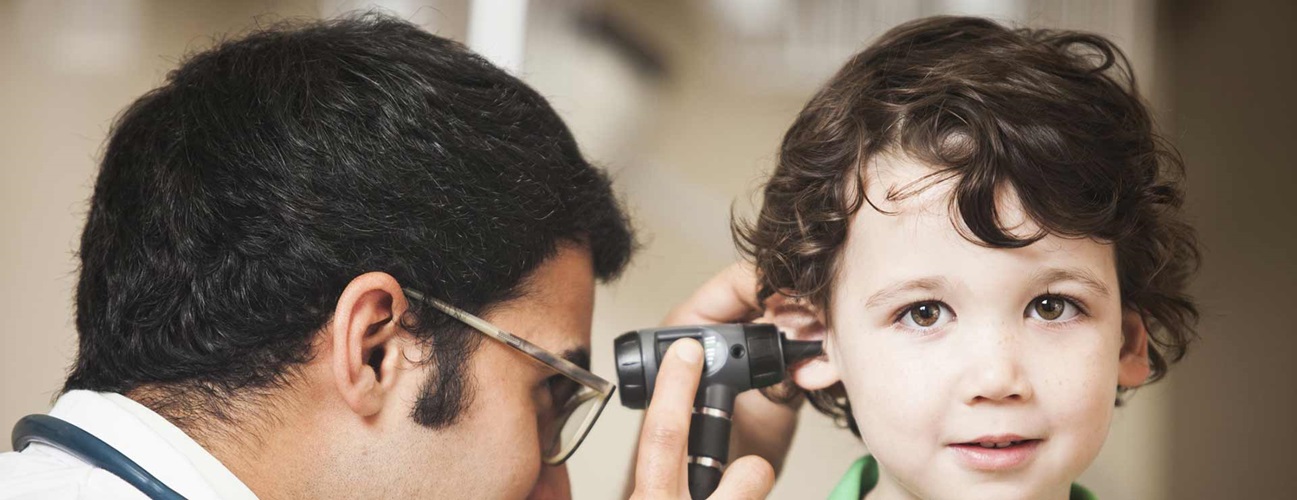Tympanoplasty
Your surgeon may recommend a tympanoplasty — a procedure to repair a perforated tympanic membrane (eardrum), to remove middle ear masses and to improve hearing.
What You Need to Know
- The goal of tympanoplasty is to reconstruct the eardrum. Sometimes, the surgeon also needs to repair the tiny bones in the middle ear and their connection to the eardrum.
- The surgeon may get to the eardrum using an incision in front of or behind the ear, and in some cases can do the repair through the ear canal without any incisions.
- The eardrum is visualized using a microscope or an endoscope to allow for precision. The surgeon patches the eardrum using a graft (soft tissue from the patient’s body, such as fascia or cartilage) or manufactured material.
- Recovery after tympanoplasty takes a few days to several weeks, but it may take two months or longer for the eardrum to fully heal and for hearing to improve.
What is tympanoplasty?
Tympanoplasty is microsurgery ― surgery using a microscope or endoscope― to fix holes in the eardrum that do not heal on their own. The eardrum, also called the tympanic membrane, enables a person to hear by vibrating in reaction to sound. A small hole may not affect hearing much, but a larger one or one in a particular area of the eardrum may cause hearing problems.
Tympanoplasty is sometimes performed together with other procedures to correct related problems in the middle ear. These procedures include:
- Ossiculoplasty (reconstruction of the ossicles, which are the tiny bones in the middle ear) to fix the connections among the ossicles, which are attached to the eardrum and help amplify sound. The three ossicles are named malleus, incus and stapes.
- Mastoidectomy removes diseased cells from the mastoid bone in the skull, behind the ear. Tympanomastoidectomy is used for patients with chronic middle ear infections that cause inflammation of the mastoid (mastoiditis), or to remove cholesteatomas (skin growths).
Who might need tympanoplasty surgery?
A tympanoplasty may be needed to repair a perforated eardrum that does not heal on its own. Signs that the eardrum is not healing include persistent hearing loss and drainage from the ear (otorrhea).
Adults or children can get a hole in the eardrum from:
- Head trauma
- Repeated or severe ear infections
- Surgery, such as placement of ear tubes
- Cholesteatoma (skin cyst in the ear)
- Inserting something into the ear canal, such as a cotton swab
- A sudden change in pressure, such as from a wave slapping the eardrum or a blast injury
Because children are more likely than adults to develop ear infections, to receive ear tubes or to insert things in their ears, they are more likely to have eardrum perforation that needs tympanoplasty.
The physician may perform the following to determine if tympanoplasty will help address symptoms:
- Medical history and physical examination
- Examination of the ear using an otoscope and a microscope to visualize the eardrum
- Comprehensive audiometry with age-appropriate hearing tests
- Tympanometry, which is a test to measure the eardrum’s movement when pressured air is directed into the ear canal
- A CT (computerized tomography) scan, especially if a cholesteatoma is suspected
- A questionnaire that helps the doctor understand the impact of the symptoms on the patient’s quality of life
What happens during tympanoplasty?
A very simple eardrum repair may be conducted in a doctor’s office with local anesthesia. But for most patients, especially children, tympanoplasty is performed in an operating room with general anesthesia. Patients can usually go home the same day.
Once the patient is asleep under anesthesia:
- The surgeon enters the ear through the ear canal or an incision behind or in front of the ear. The approach depends on the size and location of the hole in the eardrum and if the ossicles are displaced or damaged.
- After locating the hole in the eardrum with a microscope or endoscope, the surgeon removes the edges of the hole and then closes it with a graft, which is a patch of tissue from the patient or a manufactured material. The graft supports growth of new cells and over time closes the hole in the eardrum. The graft may cover just the hole or the entire eardrum.
- The graft is secured to the ear canal (and to other structures, depending on the type of tympanoplasty) with a spongy packing that dissolves over time as the eardrum tissue grows back together and heals. The healing process takes weeks or months.
The duration of the surgery depends on the extent of repairs. Repair of a small eardrum perforation may take only a few minutes, while more complex surgeries that require reconstruction of the ossicles or removal of the mastoid bone may last several hours.
Tympanoplasty Complications and Side Effects
You or your child may experience the following after tympanoplasty.
- Nausea and vomiting for the first 24 to 48 hours
- For three to five days:
- Mild to moderate pain in the ear or at the incision site
- A low-grade fever
- A clear, pink or bloody drainage from the ear, particularly when using ear drops
- Dizziness or unsteadiness for several days
- Decreased hearing in the operated ear for several weeks
Call your physician if you have or your child has:
- Fever greater than 102 degrees
- Severe ear pain, or pain more than seven days after surgery
- Excessive drainage
- Blood from the ear
- Swelling or drainage from the incision site
- Dizziness that lasts more than one week
- Decreased movement of the face or inability to close an eye
Tympanoplasty Recovery
Your doctor may recommend the following after tympanoplasty.
- Avoid vigorous sports and exercise, heavy lifting and physical education activities for two weeks or more.
- The nose should not be blown for two weeks.
- Sneeze with an open mouth.
- It is OK if the sutures get wet, but the ear canal should stay dry for several weeks. Your doctor will advise when the ear can get wet. Until then:
- Place a cotton ball coated with petroleum jelly in the ear(s) when bathing or washing hair (hair can be washed two days after surgery).
- No swimming for four to six weeks.
- Wound (incision) care:
- A large dressing may be applied after surgery and should be left in place for one or two days.
- After the dressing is removed (during an appointment or at home as instructed by your doctor), clean the incision with hydrogen peroxide and apply anti-bacterial ointment. Use cotton swabs or cotton balls to clean the incision, and wash your hands before and after cleaning the incision.
- Apply a cotton ball to the outside of the ear canal if drainage occurs.
- After the incision heals, keep the incision protected from the sun for six to 12 months by covering it or by applying sunscreen.
- Medications
- For pain control, most patients can use acetaminophen or ibuprofen, but some will need prescription pain medication.
- Antibiotic ear drops may be prescribed several weeks after surgery and should be applied at room temperature. Oral antibiotics may be prescribed for use seven to 10 days after surgery in some cases.
Children who have had a tympanoplasty can participate in quiet activities the day of surgery and return to their routines, including school, after three to five days, if they are eating and sleeping well and pain is well controlled.
Pediatric Otolaryngology

Our pediatric otolaryngologists provide compassionate and comprehensive care for children with common and rare ear, nose, and throat conditions. As part of the Johns Hopkins Children's Center, you have access to all the specialized resources of a children's hospital.
Tympanoplasty Surgery Recovery Time
Because the inside of the ear is very delicate, eardrum healing after tympanoplasty takes a long time. The patch serves as a foundation for new cells to grow and repair the hole or tear in the eardrum, and this happens gradually. Although pain, fever and discharge normally clear up within a week, hearing may be decreased for two or three months until the repaired eardrum heals completely.
Tympanoplasty Failure Symptoms
The success rate for tympanoplasty varies depending on the condition of the eardrum, the presence of infection and other disease, and if prior ear surgery was performed. In 75%–90% of cases, eardrum holes can be successfully repaired with this surgery. However, in rare cases, the surgery does not repair the eardrum and middle ear or resolve the hearing problems, and additional surgery may be necessary.
Symptoms of tympanoplasty failure or complications include:
- Pain
- Bleeding
- Persistent ear drainage
- Persistent dizziness
- Recurrence of cholesteatoma
- Hearing loss
- Change in taste
- Facial weakness, including asymmetry and eye closure deficiency
- Worsening tinnitus





